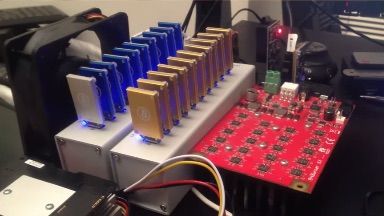
Bitcoin mining is one of the ways in which you can obtain this digital currency. To get Bitcoins, the so-called miners use the computational power of machines that nowadays must have specialized software and hardware, and which can make millions of mathematical calculations per second.
Whenever a miner or group of miners (pool) solves the necessary mathematical problems to verify the transactions and complete a new block, a certain number of Bitcoins will be distributed proportionally among them, depending on the computing power each contributed.
But mining isn’t only about making money, it’s also a primordial part in the operation of any crypto-currency. Miners make the Bitcoin network stable and secure, by releasing new Bitcoins and verifying transactions made by any user, which will eventually be added to the Blockchain.
How to earn Bitcoins by mining
amzn_assoc_placement = “adunit0”;
amzn_assoc_search_bar = “false”;
amzn_assoc_tracking_id = “miners0d-20”;
amzn_assoc_ad_mode = “manual”;
amzn_assoc_ad_type = “smart”;
amzn_assoc_marketplace = “amazon”;
amzn_assoc_region = “US”;
amzn_assoc_title = “”;
amzn_assoc_linkid = “2449318165efeb69e04cb0ab62d11040”;
amzn_assoc_asins = “B005NGQWL2,B016CWBYJK,B00RCTIY4G,B013WW2YWE”;
Mining blocks
By confirming complete transaction blocks, miners release new Bitcoins which they receive as compensation for their work. These released Bitcoin become part of a system and make it grow.
Since 2016 every time a miner or group of miners resolves a new block, they receive a compensation of 12.50 Bitcoins, it’s expected that in 2020 that reward will be of 6.25 BTC. This reward division is known as “halving” and will be explained below.
Commissions
Fees or commissions have to be paid for many of the transactions made with Bitcoins, which will be later reverted to the miners. Transaction fees play an important role in the speed with which a miner can verify these transactions, so the higher the fee, the more interest a miner will have to add it to the block and the faster it will be confirmed, and finally added to the Blockchain.
All transaction fees included in a block will be a complement added to the miner’s compensation or for resolving that entire block. Some transactions involve a 0BTC payment, so some miners will have to verify them without receiving a compensation.
The average fee per transaction is approximately 0.0001 ฿, but it varies.
Is it easy to mine Bitcoins?
At the beginning it was very easy and anyone with a personal computer could do it. But nowadays the difficulty of the mathematical calculations has increased, and requires a higher processing power.
One of the most common practices among miners who don’t have large hardware is to join “mining pools”, or miner groups, to join forces. The earnings due to block decryption are divided based on the power (hashes and shares) that each contributed.
Bitcoin mining is compared to gold mining. The idea is that any miner can decide to start looking for gold, invest in more advanced machinery to help him find more, collaborate with other miners and distribute the profits, or invest to create a large gold mine with trucks, bulldozers, and miners to work for him.
[featured site=’eToro’ ][/featured]
Mining farms
To get an idea of what large-scale miners use to generate Bitcoins, here’s a 360-degree video of a Chinese mine, which is one of the biggest installations in the world and is definitely worth seeing. Both in this type of installation as in most homemade ones, one needs to take into account the required space, the price of the equipment, its maintenance and the electric energy that it consumes. In addition to thinking about the continuous evolution of hardware, one needs to consider the growing difficulty of mining Bitcoins and their increasingly volatile price.
Any investment should always be thoroughly thought out.
Bitcoin Halving
The compensation reduction process is programmed, and happens once 210,000 blocks have been mined, which happens approximately every 4 years.
The reward earned for resolving a complete block started with 50 Bitcoins in 2009, in 2012 it was 25, and in 2017, every time a block is solved, 12.5 Bitcoins are released as compensation to the miners. Generally after each “halving” the price of the Bitcoin goes up, so the system compensates for it.

